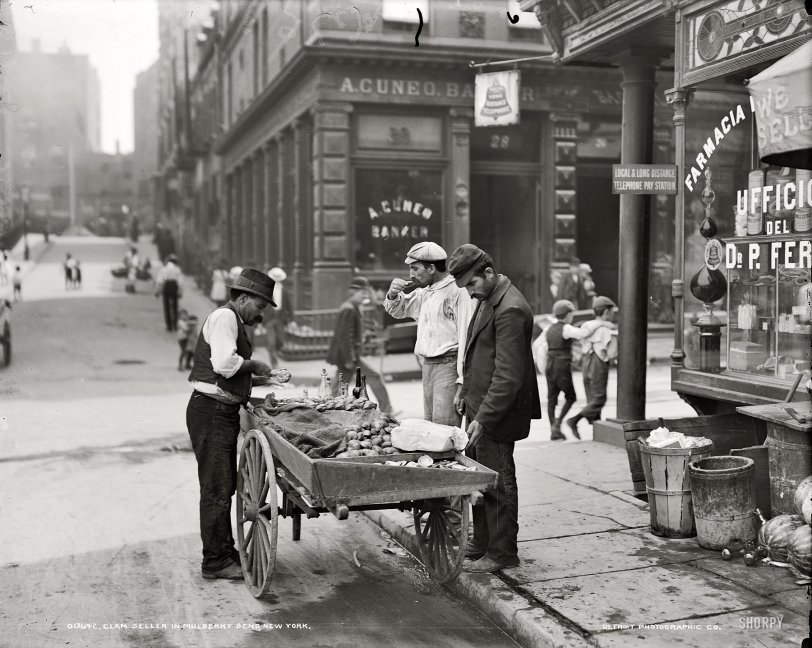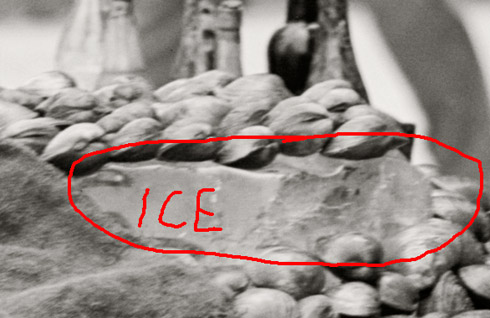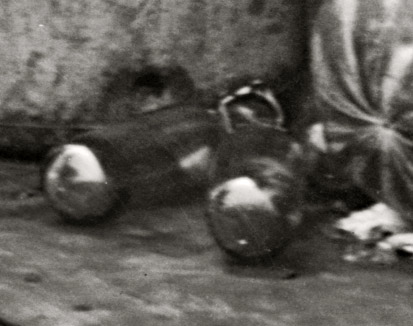


Framed or unframed, desk size to sofa size, printed by us in Arizona and Alabama since 2007. Explore now.
Shorpy is funded by you. Patreon contributors get an ad-free experience.
Learn more.

- Illuminate us
- I remember it well
- I can't prove it
- Complicated then, forgotten now
- Bryan-Stevenson
- Skinny is as skinny does
- How do you rest in peace
- Riding the footboards
- Alas, hidden from view
- Baldwin Diesels
- Exclusive pump
- Bananas, Oysters and Smokey Joe
- Details, Details
- What's that building to the left of the tower?
- Coal Barges
- Bromo-Seltzer
- Inner harbor
- The Basin
- What a headache!
- Giant stepladder?
- Yeah, it was cold
- Love those coats
- Link & Pin Days Remnant
- Baldwin 62303
- Baldwin VO-1000
- Cold
- No expense spared
- Tough Guys
- What's your hurry, where's your hat?
- Sheriff's Signature
Print Emporium
Street Clams: 1900

New York City circa 1900-1906. "Clam seller in Mulberry Bend." Detroit Publishing Company glass negative. View full size.
Phew!
I, for one, am glad we don't have online smell-o-vision. I can only imagine what this hard working peddler smelled like when he arrived home at the end of a long day in the sun with his clams. I wonder if he relocated his cart to take advantage of the shade ...
[Hello? He's already in the shade. - Dave]
Just like I like them
I used to eat clams like this right off the street at Haymarket in Boston. I'd grab 3 or 4 very Friday on the way in to work at 8am. The seller had a cart and a mustache just like this guy, but with the addition of a stubby cigar.
Sanitaria
I always read with interest comments about how quaint or unsanitary (the latter probably deservedly) such food carts/stalls are. Yet if one were to visit many parts of the modern world such as Asia, Africa and the Middle East, such gastronomy is still very much alive.
In fact, sanitary conditions in some places make this street look like a hospital, yet we don't die and rarely become ill.
Analogously, Americans marvel at how wonderful "new" fruit and meat markets are (like the one in Lancaster a few days ago) yet even in modern Europe, they thrive as they have for centuries.
Artistry
Look at that wonderful stained-glass window in the upper right!
Family Air.
I'm Italian and the moment I opened this page I perceived a strong feeling of familiarity, which was later explained by what I read in the previous comments.
The three personages into focus could have certainly been my compatriots a century ago, although from very distant regions of Italy but only an exercised American eye could ascertain, making a fair guess, if the two younger one were Second Generation Americans or not: stances of the body mean a lot.
Instead, about the racial appartenance of the personages in the background I can say very little. They are dressed as we were dressed in Italy in those same years, only better of course! But, taken for granted that all the bystanders were Italians, I can vouch about their collective and individual respectability; that is not a mob.
Cold and Clammy
Let's trust the honesty and the competence of that pedlar. Just look at how soaked is the road slope under the cart. But, again, why bother of the sanitary conditions of a trade whose customers are extinct by now?
Mosco, er Cross, er Park
At the time of the photo, Mosco Street was called Park Street, and was indeed much longer. Cuneo's bank is listed as being at the intersection of Mulberry and Park. Cross is another old name for the same street.
Though the building is still there, Cuneo was already gone. He died in 1896, not long after his run-in with San Francisco authorities. At one time, it is said that he owned more than half the buildings in the Mulberry Bend area at one time. The bank building in the photo was seen as a cornerstone of the neighborhood. Ironically (or maybe not), it's now in the middle of Chinatown.
Clam Warfare
Mosco is the former Cross Street; the neighborhood is the infamous Five Points -- a tenement slum known mostly for its Irish and Italian gangs, along with murder, disease, and poverty. Al Capone was a member of the Five Points gang. The name comes from the intersection of Orange (Baxter) and Cross (Mosco), with Anthony (Worth) connecting diagonally. Little Water (no longer extant) and Mulberry were the boundaries. This is the neighborhood where the Scorsese movie "Gangs of New York" was set.
Danger Clams
I hope there is a lot of ice we can't see. Judging from the clothes, it is warm weather and clams spoil quickly.
[Actually there is a lot of ice we can see. - Dave]

Can anyone identify
the two objects in the lower right corner of the photo to the left of the watermelons?
[Two bottles. Maybe reflecting the photographer. - Dave]

Just behind
. . . the two boys are posing for Lewis Hine.
Mosco at Mulberry
Thanks to a NYT news item on Cuneo the Banker.
[Fascinating. So it looks like Mosco street used to cross Mulberry where the park is now. The pharmacy was where the basketball court is. - Dave]
Charming
picture of street life circa 1900. Notice the two boys, one's arm around the other off to some boyhood adventure. I can hear Jimmy Stewart saying, "Hot Dog!"
Mulberry Bend
The photo is full of charm, but this Lower East Side tenement neighborhood of immigrant Italians was generally regarded as impossibly dangerous by middle and upper class New Yorkers, all too often with ample good reason. The photo might have been taken by Jacob Riis (1849-1914), famous for his documentary photos of poverty and gang life in the Bowery, Five Points and other less fashionable neighborhoods in New York.
[The picture was taken by a photographer under contract to Detroit Publishing. The Riis photos are a separate series. - Dave]
Awesome pic
My father is always telling me stories about what they used to sell on the streets from the carts. I love it!
























On Shorpy:
Today’s Top 5